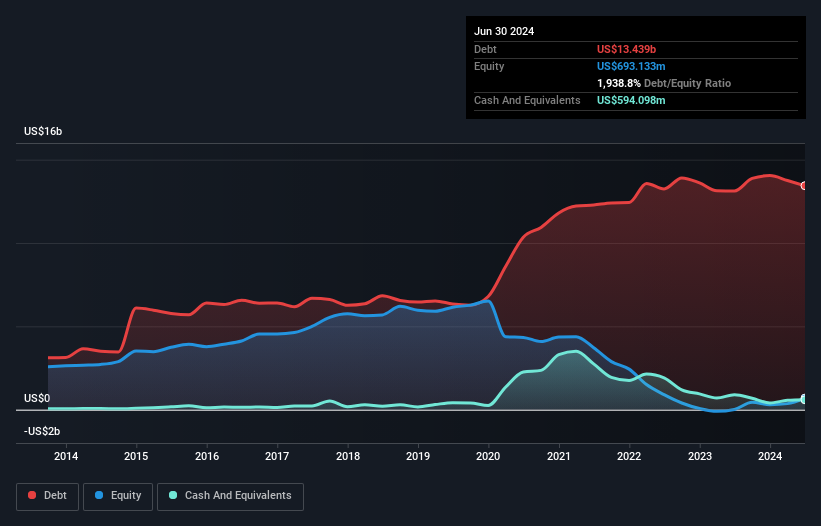Please use a PC Browser to access Register-Tadawul
Norwegian Cruise Line Holdings (NYSE:NCLH) Has No Shortage Of Debt
Norwegian Cruise Line Holdings Ltd. NCLH | 19.44 19.46 | +0.52% +0.10% Post |
Howard Marks put it nicely when he said that, rather than worrying about share price volatility, 'The possibility of permanent loss is the risk I worry about... and every practical investor I know worries about.' When we think about how risky a company is, we always like to look at its use of debt, since debt overload can lead to ruin. As with many other companies Norwegian Cruise Line Holdings Ltd. (NYSE:NCLH) makes use of debt. But should shareholders be worried about its use of debt?
Why Does Debt Bring Risk?
Debt assists a business until the business has trouble paying it off, either with new capital or with free cash flow. Ultimately, if the company can't fulfill its legal obligations to repay debt, shareholders could walk away with nothing. However, a more usual (but still expensive) situation is where a company must dilute shareholders at a cheap share price simply to get debt under control. Of course, the upside of debt is that it often represents cheap capital, especially when it replaces dilution in a company with the ability to reinvest at high rates of return. The first thing to do when considering how much debt a business uses is to look at its cash and debt together.
How Much Debt Does Norwegian Cruise Line Holdings Carry?
As you can see below, Norwegian Cruise Line Holdings had US$13.4b of debt, at June 2024, which is about the same as the year before. You can click the chart for greater detail. However, it also had US$594.1m in cash, and so its net debt is US$12.8b.

How Healthy Is Norwegian Cruise Line Holdings' Balance Sheet?
Zooming in on the latest balance sheet data, we can see that Norwegian Cruise Line Holdings had liabilities of US$6.63b due within 12 months and liabilities of US$12.8b due beyond that. Offsetting these obligations, it had cash of US$594.1m as well as receivables valued at US$209.3m due within 12 months. So it has liabilities totalling US$18.6b more than its cash and near-term receivables, combined.
This deficit casts a shadow over the US$7.45b company, like a colossus towering over mere mortals. So we'd watch its balance sheet closely, without a doubt. After all, Norwegian Cruise Line Holdings would likely require a major re-capitalisation if it had to pay its creditors today.
We measure a company's debt load relative to its earnings power by looking at its net debt divided by its earnings before interest, tax, depreciation, and amortization (EBITDA) and by calculating how easily its earnings before interest and tax (EBIT) cover its interest expense (interest cover). Thus we consider debt relative to earnings both with and without depreciation and amortization expenses.
Norwegian Cruise Line Holdings shareholders face the double whammy of a high net debt to EBITDA ratio (6.0), and fairly weak interest coverage, since EBIT is just 1.6 times the interest expense. The debt burden here is substantial. One redeeming factor for Norwegian Cruise Line Holdings is that it turned last year's EBIT loss into a gain of US$1.2b, over the last twelve months. When analysing debt levels, the balance sheet is the obvious place to start. But it is future earnings, more than anything, that will determine Norwegian Cruise Line Holdings's ability to maintain a healthy balance sheet going forward.
Finally, a business needs free cash flow to pay off debt; accounting profits just don't cut it. So it's worth checking how much of the earnings before interest and tax (EBIT) is backed by free cash flow. During the last year, Norwegian Cruise Line Holdings burned a lot of cash. While investors are no doubt expecting a reversal of that situation in due course, it clearly does mean its use of debt is more risky.
Our View
To be frank both Norwegian Cruise Line Holdings's conversion of EBIT to free cash flow and its track record of staying on top of its total liabilities make us rather uncomfortable with its debt levels. But at least its EBIT growth rate is not so bad. After considering the datapoints discussed, we think Norwegian Cruise Line Holdings has too much debt. While some investors love that sort of risky play, it's certainly not our cup of tea. When analysing debt levels, the balance sheet is the obvious place to start. But ultimately, every company can contain risks that exist outside of the balance sheet. Be aware that Norwegian Cruise Line Holdings is showing 3 warning signs in our investment analysis , and 1 of those is concerning...
At the end of the day, it's often better to focus on companies that are free from net debt. You can access our special list of such companies (all with a track record of profit growth). It's free.
This article by Simply Wall St is general in nature. We provide commentary based on historical data and analyst forecasts only using an unbiased methodology and our articles are not intended to be financial advice. It does not constitute a recommendation to buy or sell any stock, and does not take account of your objectives, or your financial situation. We aim to bring you long-term focused analysis driven by fundamental data. Note that our analysis may not factor in the latest price-sensitive company announcements or qualitative material. Simply Wall St has no position in any stocks mentioned.



